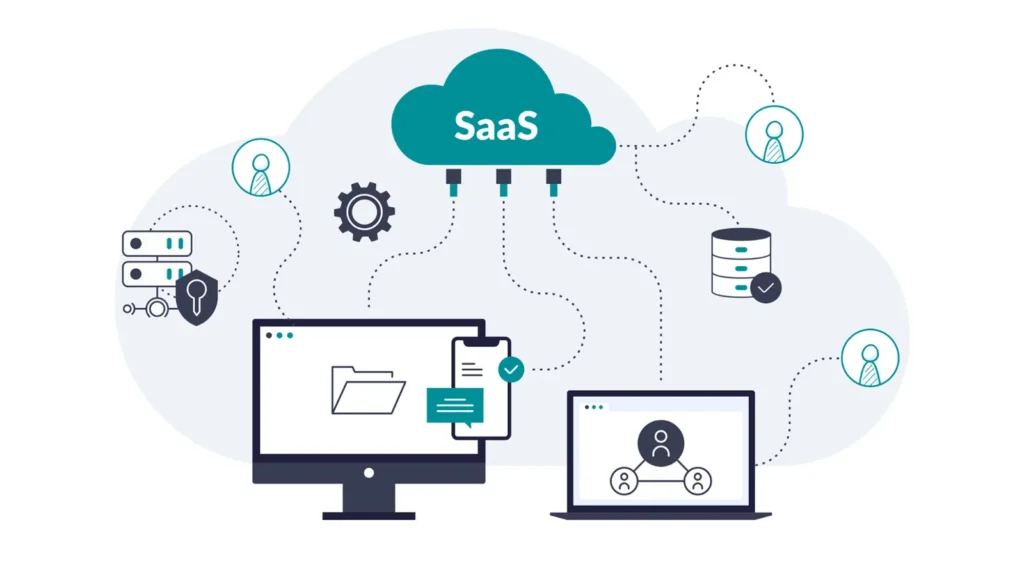How many times has it happened that we need something just for a short period of time, it could be any necessity, a product, or a service? And when your one-time use or short operational need is fulfilled, the bought thing just sits there unused. It feels like a waste, doesn’t it?
Now, what if I tell you that you have an option to use something when you need to and can stop paying for it when it is no longer of use to you? Amazing right? That’s exactly what SaaS (Software as a Service) is about, and I will tell you how you can take advantage of SaaS sales to fulfill your short-term business needs without hefty investments that no longer serve you in the future. We will dive into the SaaS sales process, types of SaaS subscription models, how SaaS sales strategies for startups can be an asset, and much more.
What is SaaS Sales & How Does it Work?
We know that SaaS applications or products are cloud-based and they work via of internet, and the users (businesses/companies) do not require any heavy infrastructure to run them. So with the help of SaaS sales, people can use the software online by subscribing to it without needing to install it on computers or purchase it. Meaning the customers do not own the software, they just pay a certain amount of monthly or yearly subscription charge as long as they need to use it. You can think of apps and services like Netflix, Zoom, Google Workspace, Salesforce, and many more.
In SaaS sales, the focus is not just about gaining customers but about retaining them to keep using your services. It’s about helping and guiding customers towards satisfaction and becoming your long-term client.
Step-by-Step SaaS Sales Process with Example

1. Lead Generation
Find out who needs your services with the help of ads, marketing, webinars, or referrals.
Salesforce attracts and gains potential customers through online advertising, content marketing, and several industry events to target companies looking for a CRM solution.
2. Lead Qualification
This involves checking if the lead is a good fit or not by understanding their budget, need, and buying authority. Focus on high-intent leads.
For example, now Salesforce, a sales rep, evaluates if the company really needs a CRM, what their userbase is, and who decides on purchases.
3. Free Trial or Demo
Let your prospect understand the software by providing them with free demonstrations, trials, and interactive sessions.
Salesforce will show how its Sales Cloud works to track leads, manage deals, and analyze sales performance. It helps prospects experience real gains before actually committing to a deal.
4. Plan & Pricing
After the above steps, now comes to finalize the terms by discussing tailored packages and plans as per the client’s needs, deciding on pricing, and negotiating terms.
The Salesforce sales representative will customize a plan, including the number of users, add-ons like cloud benefits, etc. And works with clients on contract terms.
5. Closing
Once the terms and conditions are agreed upon, the subscription completion is done, billing methods are set up, and the company makes sure about a smooth onboarding.
Now that the client has signed up for Salesforce, they are provided login credentials, and the sales rep manages the onboarding process with the customer success team.
6. Customer Support
Now that you have successfully managed to get a customer to use your services, you need to retain them longer. As we said above that SaaS sales are not about sales but retention. And that is what is done after successful onboarding, as the client is followed up, provided support and knowledge to understand the value of the software, which makes them move toward renewals and upgrades.
Salesforce’s customer retention team will regularly check in, offer training, and help the client use upgraded features to make sure they continue subscribing and upgrading to more advanced plans.
Related: What is iPaaS & SaaS? Key Benefits, Use Cases, and Differences
What is the SaaS Sales Funnel?
The sales funnel in SaaS sales is about the comprehensive journey of the process, from where a potential customer comes to know about your service to becoming a paid subscriber of your services and ideally a loyal, long-term client. With the help of a sales funnel, SaaS companies can proceed through each step and stage with the right plan of action, which helps to turn a prospect into a satisfied, sustained customer.
Awareness → Interest → Consideration → Decision → Retention
Difference Between SaaS Sales and Traditional Sales
| Aspect | Traditional Sales | SaaS Sales |
|---|---|---|
| Product Type | Physical goods or one-time software licenses | Cloud-based software accessed via subscription |
| Revenue Model | One-time payment | Recurring revenue (monthly or yearly subscriptions) |
| Customer Focus | Single transaction | Long-term relationship and customer success |
| Sales Cycle | Ends after purchase | Ongoing; includes renewals and upgrades |
| Support & Engagement | Limited post-sale support | Continuous support and engagement to reduce churn |
| Sales Approach | Feature-focused selling | Value-based selling; problem-solving for the customer |
| Growth Driver | New customers | New customers + retention + upselling |
Importance of SaaS Sales in Business Growth
Saas sales are crucial because they focus on consistent revenue growth. It is not just making people a user one time but encouraging them to keep using the service or product. But is it actually beneficial? In traditional sales, a customer usually buys once and doesn’t have much chance of returning to a vendor, compared to SaaS sales.
Because in SaaS sales user is on a subscription basis, and you are constantly in direct touch with them to understand the value of the software, help them with issues, and guide them through the upgrades.
Therefore, there is a high chance of retaining a customer, which will help businesses achieve determined and sustainable growth. The global cloud market is expected to cross $400 billion in 2025.
SaaS Subscription Models
| Type | Description |
|---|---|
| Revenue Type | Monthly or yearly periodic payments help to determine income for the business. |
| Customer Relationship | Continuous engagement with customers through support, updates, and guidance to reduce customer loss risk. |
| Pricing Models | Options include tiered plans, usage-based pricing, or freemium models, allowing flexibility for different customer needs. |
| Sales Focus | The focus is on onboarding, customer success, and retention by upselling and renewals rather than one-time transactions. |
| Benefits for Business | Provides predictable revenue, easier scaling, and valuable insights into customer behavior over time. |
| Benefits for Customers | Flexible access without large upfront costs, always updated software, and support when needed. |
Also Read: SaaS Business Intelligence: Be On Top In Business Just By Organizing Data
SaaS Sales Strategies for Startups
By implementing a SaaS sales strategy, startups can build a loyal customer base for sustainable and cyclic growth. Startups need to have a well-polished SaaS sales plan. Research from ChartMogul showed that SaaS startups saw a staggering growth of $10M from $1M in ARR simply by increasing their customer base. This clearly shows the importance of sales in SaaS.
Some major benefits:
- Predictable revenue streams
- Better customer retention
- Measured growth opportunities
- Efficient customer attainment
- Data-driven decision-making
Limitations of SaaS Sales
As beneficial as SaaS sales are, they come with certain limitations.
- The market is full of vendors and service providers; you must stand out, and it is not so easy to do.
- Defection risk is another challenge as the revenue is subscription-based, and losing customers can directly affect the overall revenues.
- Longer sales cycle for B2B as complex software may demand several demos and approvals, and is difficult to negotiate.
- High dependency on the internet and cloud system; therefore, any technical issue or downtime can affect customer satisfaction.
- Due to multiple providers in the market, there can be pressure to limit price flexibility.
- Consistent after-sales support is required to be given to clients to assist them in fixing bugs or errors and managing updates.
Conclusion
In simple words, SaaS sales are beyond one-time purchases. It’s about building the relationship and then nurturing it for a prolonged period by delivering value to customers on a consistent basis. We saw that there is a difference between SaaS sales and traditional sales, and how different SaaS sales processes and SaaS subscription models can be beneficial for growing a business and earning long-term profits in terms of money and name recognition.
Noting the importance of SaaS sales in business growth, Fortune Business Insights mentioned the projection of global SaaS market growth from $315.68 in 2025 to $1,132.52 by 2032 with a CAGR of 20% during the forecast period.
At the end, when you do SaaS sales, you are not just selling technical solutions and comfort, but gaining lasting trust by solving real problems.
Related: Outsourcing SaaS Development: Cost-Efficient, Expertized & Faster Launch








